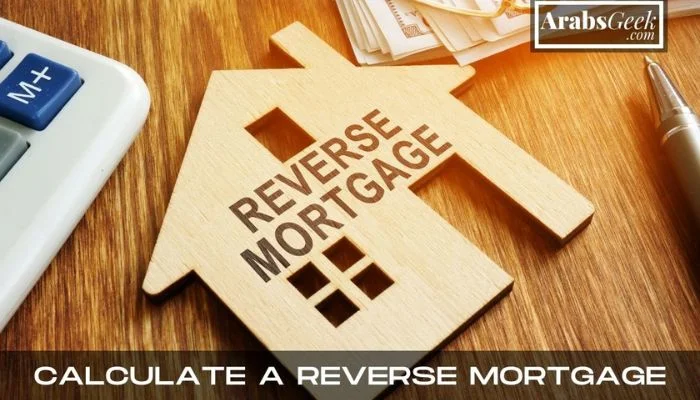Introduction | Calculate A Reverse Mortgage
If you’re a homeowner who’s reached the age of 62 and you’re looking for ways to supplement your income, you might have considered a reverse mortgage. But how do you calculate a reverse mortgage? This article will break down what a reverse mortgage is, its benefits, how to calculate it, considerations, and alternatives.
Table of Contents
Understanding Reverse Mortgages
What is a reverse mortgage?
A reverse mortgage is a loan option for homeowners aged 62 or older, allowing them to convert a portion of their home’s equity into cash. Instead of making monthly mortgage payments, the money flows in the opposite direction, from the lender to the homeowner.
For any business enquiry, you can contact us at ArabsGeek.com
For more of such financial articles, Consider visiting our sister website at EntrepreneursPilot.com
How does a reverse mortgage work?
In a reverse mortgage, the homeowner receives money from the lender and is not required to pay it back until the homeowner moves out, sells the house, or passes away. The money received can be given as a lump sum, monthly payments, or as a line of credit.
Benefits of Reverse Mortgages | Calculate A Reverse Mortgage
No monthly mortgage payments
One of the most significant benefits of a reverse mortgage is that there are no monthly mortgage payments. This can help free up cash for other expenses, such as healthcare costs, home improvements, or just daily living expenses.
Increase in cash flow
By tapping into your home equity, a reverse mortgage can provide a steady stream of income, especially helpful during retirement when consistent income might be hard to come by.
Flexible payment options | Calculate A Reverse Mortgage
You can choose to receive the reverse mortgage proceeds in a way that best suits your needs, whether it be a lump sum, monthly payments, a line of credit, or a combination of these.
How to Calculate a Reverse Mortgage
Step 1: Know Your Home’s Value
The first step in calculating a reverse mortgage is to know your home’s current market value. This can be done through an appraisal.
Step 2: Age of the Youngest Borrower
The age of the youngest borrower or non-borrowing spouse is considered when calculating the amount of proceeds you will receive. The older you are, the more money you are likely to receive from a reverse mortgage.
Step 3: Current Interest Rate
The current interest rate also plays a role in the amount of money you can receive from a reverse mortgage. Lower interest rates mean more borrowing power.
Step 4: Use a Reverse Mortgage Calculator
Once you’ve gathered all this information, you can use a reverse mortgage calculator, which can easily be found online. These calculators use the information provided, such as your home’s value, your age, and current interest rates, to estimate the amount you might receive in a reverse mortgage.
Things to Consider When Getting a Reverse Mortgage
Fees and costs | Calculate A Reverse Mortgage
Just like a traditional mortgage, reverse mortgages come with several fees and costs, including origination fees, closing costs, servicing fees, and mortgage insurance premiums. Make sure to factor these costs into your decision.
Implications for your estate
Keep in mind that a reverse mortgage could potentially deplete the equity in your home, which might affect the amount of inheritance you leave for your heirs.
Financial assessment | Calculate A Reverse Mortgage
Lenders will conduct a financial assessment to ensure you can meet the ongoing obligations of the reverse mortgage, such as property taxes, insurance, and property maintenance.
Alternatives to Reverse Mortgages
Home equity loan or line of credit
A home equity loan or line of credit also allows you to tap into your home’s equity but requires you to make regular monthly payments.
Selling your home | Calculate A Reverse Mortgage
Another option could be to sell your home and downsize. This option could potentially provide you with extra cash and reduce your living expenses.
Renting your home
If you have an extra room or a second property, you might consider renting it out for extra income.
Conclusion | Calculate A Reverse Mortgage
Calculating a reverse mortgage can provide a good understanding of whether this option fits your financial plan. By knowing your home’s value, considering the age of the youngest borrower, current interest rates, and using a reverse mortgage calculator, you can estimate the proceeds from a reverse mortgage.
Frequently Asked Questions (FAQs)
Q1. Are reverse mortgages a good idea?
Whether a reverse mortgage is a good idea depends on your specific circumstances. It can provide a steady stream of income during retirement, but there are also fees, interest, and implications for your estate to consider.
Q2. Do you lose ownership of your home with a reverse mortgage?
No, you continue to own your home with a reverse mortgage, but the lender places a lien on the house, which is paid off when the home is sold.
Q3. What happens if I outlive my reverse mortgage?
You can’t outlive a reverse mortgage. As long as you live in the home, keep up with necessary home repairs, and pay property taxes and insurance, the loan doesn’t need to be repaid.
Q4. Can I get a reverse mortgage if I still have a regular mortgage?
Yes, but the existing mortgage will need to be paid off first, either with the proceeds from the reverse mortgage or other funds.
Q5. Do my heirs have to pay the reverse mortgage after I die?
Your heirs won’t be responsible for paying your debt. They can choose to repay the reverse mortgage and keep the home or sell the home and use the proceeds to pay off the reverse mortgage.











